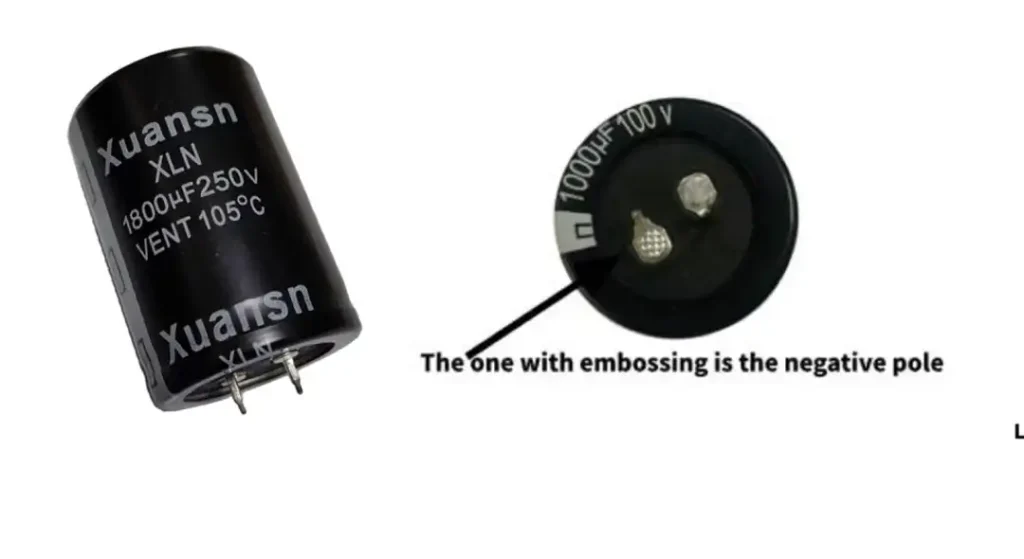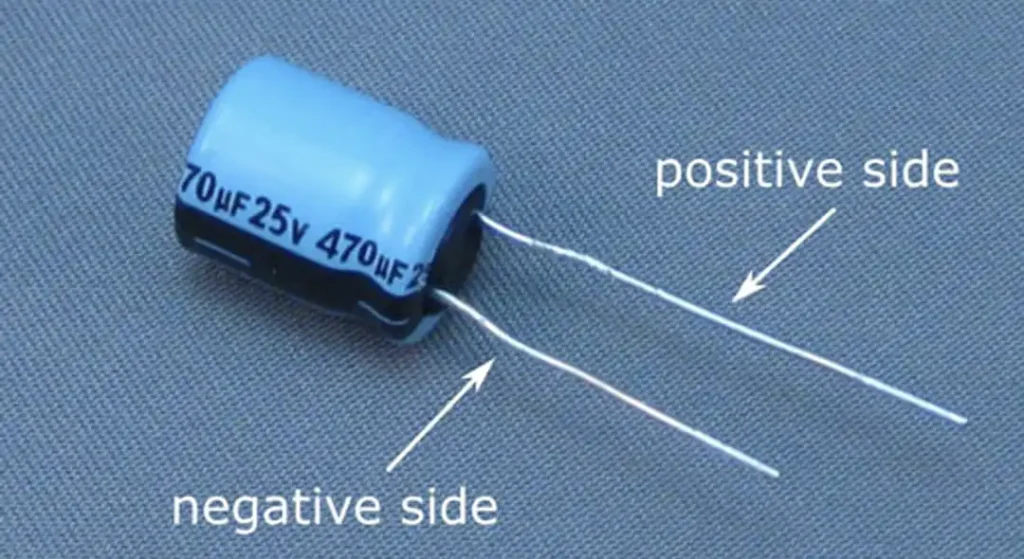Capacitors are vital components in electronic circuits, storing and releasing electrical energy when needed. However, to ensure proper functionality, it’s crucial to identify the polarity of capacitors correctly. In this comprehensive guide, we’ll delve into the intricacies of capacitor polarity, focusing on how to determine the positive and negative terminals with precision.
What is Capacitor Polarity?

Before delving into identifying capacitor polarity, let’s grasp the concept of polarity itself. In electronics, polarity refers to the positive (+) and negative (-) terminals of a component, indicating the direction of current flow. Capacitors, like other electronic components, possess polarity, denoted by their positive and negative terminals.
Types of Capacitors
Capacitors come in various types, each with its specific characteristics and applications. Some common types include:
Electrolytic Capacitors
Electrolytic capacitors are polarized, meaning they have distinct positive and negative terminals. These capacitors typically feature higher capacitance values and are widely used in power supply circuits and audio applications.
Ceramic Capacitors
Unlike electrolytic capacitors, ceramic capacitors are non-polarized, meaning they can be connected in any orientation within a circuit. These capacitors are renowned for their stability and high-frequency characteristics, making them suitable for bypass and coupling applications.
Tantalum Capacitors
Similar to electrolytic capacitors, tantalum capacitors are polarized components with specific positive and negative terminals. They offer high capacitance values in a compact form factor, making them ideal for miniaturized electronic devices.
Identifying Capacitor Polarity
Now, let’s focus on the practical aspect of identifying capacitor polarity. Here’s how to determine the positive and negative terminals of different types of capacitors:
Electrolytic Capacitors
- Markings: Electrolytic capacitors typically feature markings indicating the polarity. Look for a stripe or arrow on the capacitor body, which denotes the negative terminal.
- Longer Lead: In through-hole electrolytic capacitors, the negative terminal is often connected to the shorter lead, while the positive terminal connects to the longer lead.
- Datasheet Reference: Consult the capacitor’s datasheet for polarity information, especially when dealing with surface mount electrolytic capacitors.
Ceramic Capacitors
- No Polarity: Unlike electrolytic capacitors, ceramic capacitors do not have polarity markings. They can be connected in any orientation within the circuit.
Tantalum Capacitors
- Markings: Tantalum capacitors usually feature polarity markings similar to electrolytic capacitors. Look for a stripe or plus sign indicating the positive terminal.
- Datasheet Reference: Refer to the datasheet for specific polarity information, as it may vary depending on the capacitor’s manufacturer and specifications.
Testing Capacitor Polarity
In some cases, capacitor markings may be obscured or unreadable. In such scenarios, you can use a multimeter to test capacitor polarity:
- Set Multimeter: Switch your multimeter to the continuity or diode test mode.
- Probe Placement: Place the positive (red) probe on the capacitor’s positive terminal and the negative (black) probe on the negative terminal.
- Reading: If the multimeter shows a positive reading or beeps, it indicates that the red probe is on the positive terminal, confirming the capacitor’s polarity.
By following these methods, you can accurately determine the polarity of capacitors, ensuring proper integration within electronic circuits.
How to Know Positive and Negative of Capacitor

Capacitors are electronic components commonly used in circuits to store and release electrical energy. They have both positive and negative aspects depending on how they are used and their characteristics.
Here’s a breakdown:
Positive Aspects of Capacitors:
- Energy Storage: One of the main purposes of capacitors is to store electrical energy. They can accumulate charge when connected to a voltage source and release it when needed, making them useful for various applications such as energy storage systems and power supply filtering.
- Filtering and Smoothing: Capacitors are often used in conjunction with other components like resistors and inductors to filter out noise or ripple voltage from power supplies, resulting in cleaner and more stable electrical signals.
- Coupling: Capacitors can be used for coupling AC signals while blocking DC signals. This property is essential in amplifiers and other circuits where it’s necessary to transmit AC signals while isolating the DC component.
- Timing: Capacitors are integral to timing circuits in electronics. By controlling the rate of charge and discharge, they determine the timing intervals in various applications such as oscillators, timers, and pulse generators.
Negative Aspects of Capacitors:
- Limited Energy Storage: While capacitors are efficient at storing electrical energy, they have limited storage capacity compared to other energy storage devices like batteries. This limitation restricts their use in high-energy applications.
- Voltage Dependency: The voltage across a capacitor cannot change instantaneously. This property can cause issues in circuits where rapid changes in voltage are required, leading to delays or distortion in signals.
- Polarization: Certain types of capacitors, such as electrolytic capacitors, are polarized, meaning they must be connected in a specific orientation in a circuit. Incorrect polarization can lead to capacitor failure or malfunction.
- Leakage: Capacitors can experience leakage, where a small amount of charge dissipates over time due to imperfect insulation or dielectric material. This leakage current can affect the performance of the circuit, especially in high-precision applications.
Understanding these positive and negative aspects of capacitors is crucial for designing and troubleshooting electronic circuits effectively. By leveraging their strengths and addressing their limitations, engineers can optimize the performance and reliability of their designs.
How to Identify Positive and Negative Terminal of Capacitor
Identifying the positive and negative terminals of a capacitor is essential for correct installation and operation within an electronic circuit. Here’s how to do it:
- Look for Markings: Many capacitors have markings indicating their polarity. Common markings include a stripe, arrow, or a plus sign (+) on the positive terminal. Conversely, the negative terminal may be marked with a minus sign (-) or lack any markings at all. Always check the manufacturer’s datasheet or product labeling for specific polarity indicators.
- Check for Labeling: Capacitors may have text printed on their body indicating the polarity. This could include labels such as “positive” or “negative” next to the corresponding terminal.
- Observe the Physical Design: In polarized capacitors like electrolytic capacitors, the physical design can provide clues about polarity. The longer lead or terminal is typically the positive one, while the shorter lead or terminal is negative. Additionally, the negative terminal may be marked with a colored band or a flat edge compared to the rounded edge of the positive terminal.
- Refer to Datasheets: If the capacitor is not clearly marked or you’re unsure about its polarity, refer to the manufacturer’s datasheet. Datasheets provide detailed specifications and polarity information for specific capacitor models.
- Use a Multimeter: A multimeter set to the continuity or diode test mode can help identify the polarity of a capacitor. Connect the multimeter probes to the capacitor terminals. If the capacitor is polarized, the multimeter will indicate the polarity by showing a positive or negative reading.
- Check the Symbol: Sometimes, capacitors have polarity symbols printed directly on them. Look for a plus sign (+) near one terminal and a minus sign (-) near the other. This indicates the positive and negative terminals, respectively.
It’s crucial to identify the correct polarity before connecting a capacitor in a circuit, especially in polarized capacitors like electrolytic capacitors. Connecting a capacitor with reversed polarity can lead to damage or failure, so always double-check polarity before installation. If in doubt, consult the capacitor’s datasheet or seek guidance from an experienced electronics technician.
Conclusion
Understanding capacitor polarity is essential for electronics enthusiasts and professionals alike. By identifying the positive and negative terminals of capacitors correctly, you can prevent circuit malfunctions and ensure optimal performance. Whether you’re working with electrolytic, ceramic, or tantalum capacitors, adhering to polarity guidelines is paramount for reliable circuit design and operation.